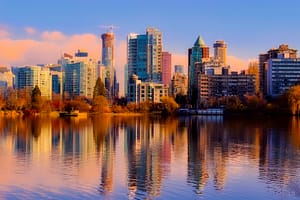Bicycle
Vancouver is a relatively good cycling city, with more than 300km of designated routes crisscrossing the region. Cyclists can take their bikes for free on SkyTrains, SeaBuses and transit buses, which are all now fitted with bike racks. Cyclists are required by law to wear helmets. In recent years, dedicated bike lanes have been created downtown and, in 2016, a new public bike-share scheme called Mobi was introduced. Pick up a free Metro Vancouver Cycling Map for details on area routes and bike-friendly contacts and resources – or download it via the TransLink website. If you’re traveling sans bike, you can also rent wheels (often including inline skates) from businesses around the city, especially on Denman St near Stanley Park – home of Vancouver’s most popular scenic cycling route.
Boat
Waterfront Vancouver makes use of its waterways for local travel, via transit services and private providers.
Miniferries
Operators offer day passes ($10 to $15) as well as discounted books of tickets for those making multiple water hops. Single trips cost from $3.50.
Aquabus Ferries Runs frequent minivessels (some big enough to carry bikes) between the foot of Hornby St and Granville Island. It also services several additional spots along the False Creek waterfront, as far as Science World.
False Creek Ferries Operates a similar Granville Island service from Sunset Beach, and has additional ports of call around False Creek.
Ferry
The iconic SeaBus shuttle is part of the TransLink transit system (regular transit fares apply) and it operates throughout the day, taking 12 minutes to cross Burrard Inlet between Waterfront Station and Lonsdale Quay in North Vancouver. At Lonsdale you can then connect to buses servicing North Vancouver and West Vancouver; this is where you pick up bus 236 to both Capilano Suspension Bridge and Grouse Mountain.
SeaBus services leave from Waterfront Station between 6:16am and 1:22am, Monday to Saturday (8:16am to 11:16pm on Sunday). Vessels are wheelchair accessible and bike-friendly.
Bus
Vancouver’s TransLink (www.translink.ca) bus network is extensive. All vehicles are equipped with bike racks and all are wheelchair accessible. Exact change (or more) is required; buses use fare machines and change is not given. Fares cost adult/child $2.75/1.75 and are valid for up to 90 minutes of transfer travel. While Vancouver’s transit system covers three geographic fare zones, all bus trips are regarded as one-zone fares.
Bus services operate from early morning to after midnight in central areas. There is also a handy night-bus system that runs every 30 minutes between 1:30am and 4am. The last night-bus leaves downtown Vancouver at 3:09am. Look for night-bus signs at designated stops.
Car & Motorcycle
For sightseeing in the city, you’ll be fine without a car (the city center is especially easy to explore on foot and transit routes are extensive). For visits that incorporate the wider region’s mountains and communities, however, a vehicle makes life much simpler: the further you travel from downtown, the more limited your transit options become.
Rental
Major car-rental agencies with offices around the city and at Vancouver International Airport:
Avis
Budget
Enterprise
Hertz
Thrifty
Train
TransLink’s SkyTrain rapid-transit network currently consists of three routes and is a great way to move around the region, especially beyond the city center. A fourth route, the Evergreen Line, is scheduled to begin operations in 2017 and will link the suburban communities of Burnaby, Coquitlam and Port Moody. Compass tickets for SkyTrain trips can be purchased from station vending machines (change is given; machines also accept debit and credit cards) prior to boarding.
Taxi
Vancouver currently does not allow Uber-type services. Try the following long-established taxi companies:
Black Top & Checker Cabs
Vancouver Taxi
Yellow Cab

